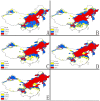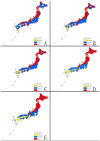Predicting the current potential and future world wide distribution of the onion maggot, Delia antiqua using maximum entropy ecological niche modeling
- PMID: 28158259
- PMCID: PMC5291381
- DOI: 10.1371/journal.pone.0171190
Predicting the current potential and future world wide distribution of the onion maggot, Delia antiqua using maximum entropy ecological niche modeling
Abstract
Climate change will markedly impact biology, population ecology, and spatial distribution patterns of insect pests because of the influence of future greenhouse effects on insect development and population dynamics. Onion maggot, Delia antiqua, larvae are subterranean pests with limited mobility, that directly feed on bulbs of Allium sp. and render them completely unmarketable. Modeling the spatial distribution of such a widespread and damaging pest is crucial not only to identify current potentially suitable climactic areas but also to predict where the pest is likely to spread in the future so that appropriate monitoring and management programs can be developed. In this study, Maximum Entropy Niche Modeling was used to estimate the current potential distribution of D. antiqua and to predict the future distribution of this species in 2030, 2050, 2070 and 2080 by using emission scenario (A2) with 7 climate variables. The results of this study show that currently highly suitable habitats for D.antiqua occur throughout most of East Asia, some regions of North America, Western Europe, and Western Asian countries near the Caspian sea and Black Sea. In the future, we predict an even broader distribution of this pest spread more extensively throughout Asia, North America and Europe, particularly in most of European countries, Central regions of United States and much of East Asia. Our present day and future predictions can enhance strategic planning of agricultural organizations by identifying regions that will need to develop Integrated Pest Management programs to manage the onion maggot. The distribution forecasts will also help governments to optimize economic investments in management programs for this pest by identifying regions that are or will become less suitable for current and future infestations.
Conflict of interest statement
The authors have declared that no competing interests exist.
Figures






References
-
- Andrewartha H.G., Birch L.C. The distribution and abundance of animals. Chicago: University of Chicago Press; 1954; 782p.
-
- Stevnbak K., Scherber C., Gladbach D. & Christensen S. Climate change strongly affects interaction between herbivorous insects, plants, and rhizosphere biota. Earth and Environmental Science. 2009;4, 042104.
-
- Jeffrey S. & Harold A. Does global change increase the success of biological invaders? Trends in Ecology and Evolution.1999; 14, 135–139. - PubMed
-
- IPCC. Climate change the physical science basis. Contribution of Working Group I to the Fourth Assessment Report of the Intergovernmental Panel on Climate Change. Cambridge University. Press. 2007b.
-
- Bale J.S., Masters G.J., Hodkinson I.D., Bezemer T.M., Brown V.K. & Butterfield J. Herbivory in global climate change research: direct effects of rising temperature on insect herbivores. Global Change Biology.2002; 8, 1–16.
MeSH terms
LinkOut - more resources
Full Text Sources
Other Literature Sources

